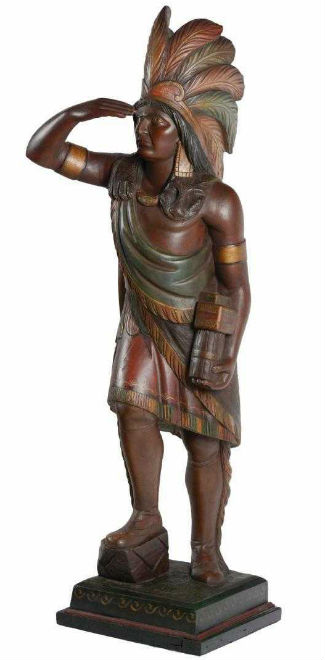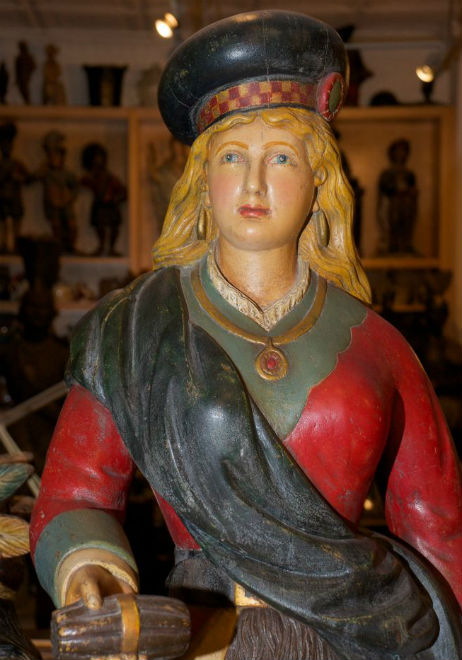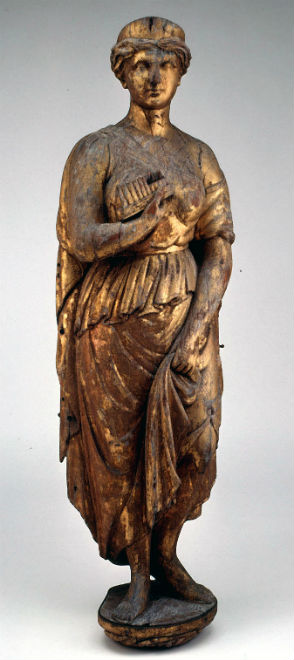
NEW YORK – Samuel A. Robb was one of the most prolific American wood carvers in the late 19th-early 20th century, well known for tobacconist trade sign figures (commonly referred to as cigar store Indians) but he designed and carved a whole range of advertising trade figures as well as carved circus wagon figures.
After serving as an apprentice to a shipbuilder/woodcarver (most likely Thomas V. Brooks, who also operated out of New York City, a hotbed for woodcarvers at the time), he worked days and studied nights at the National Academy of Design and Cooper Union, before opening his first shop on Canal Street in New York in 1876. Within 15 years, his was the largest woodcarving shop in the city, and he had a staff of around 10 people at its peak. His main competitors were fellow carvers Thomas V. Brooks and John Cromwell, who also operated leading carving shops in Manhattan during the same era.

While the market for Americana has waned in recent years, great pieces will always command top dollar and strong interest. In 2014, Sotheby’s sold a Samuel Robb-carved Santa Claus figure made in 1923 for $875,000. Native American figures by Robb or attributable to his shop are fairly common but unusual forms will increase a piece’s value. Signed pieces usually are more detailed and thus more valuable. The American Museum of Folk Art has a baseball player figure by Robb that would bring a tidy sum were it ever to come on the market, which is unlikely.
Collectors today look for a pleasing piece. “Paint surface is key, there is no question that original paint is the holy grail,” said New York City collector-dealer Mark Goldman. “We look for size and we look for movements. In other words, rather than having a staid piece where the thing looks like it is about to walk away, we look for additions that Robb put on.” His female figures, for example, were upright but some of his ladies had a crossed leg, which is more difficult to carve, making it more valuable. Some were depicting holding a rose or two.

While most pieces are unsigned, Goldman says they can often tell from Robb’s style which ones came out of his studio, even if a scholar cannot put a piece in Samuel’s hand specifically.
The Museums at Colonial Williamsburg (Va.) know this firsthand. In their collection are two carved figures that do not have firm attribution to Samuel Robb. One is possibly from the studio of Robb and the other is thought to be made by Robb or his brother, Charles, also a carver.
Laura Pass Barry, a curator at Colonial Williamsburg Foundation, explained that a figure of Terpsichore (in Greek mythology, she is one of the muses of choral song and dance, often pictured with a lyre), attributed to the studio of Robb, was acquired by museums founder Abby Aldrich Rockefeller through leading folk art dealer Edith Halpert.

“Of the carvers from that period, he seems to be one of the better known,” she said, calling Robb one of the best-documented American carvers. “He’s a known name and his products – both circus and trade – are embedded in the history of objects from our everyday life.”
The museum has a striking Santa Claus figure thought to have originated with Robb or his studio. Though firm attribution is lacking, the piece is similar in form to another example made in the shop, possibly by Charles Robb. “More research has to be done with side-by-side examples,” she said. This figure was at one time said to be used in a Lutheran church in New York City to hold printed material (the figure has a backpack with an opening where fliers and cards could be placed). It reportedly was given to a workman associated with the church and then several others before coming to the Colonial Williamsburg Foundation. “There is a Santa figure quite similar that is part of the Van Alstyne collection at the Smithsonian, that was, I believe, for Robb’s daughter.”
The museum’s other Robb-attributed figure is the carved standing figure of Terpsichore that the foundation identified in the early 2000s, thanks to research by a circus scholar who spotted the particular circus wagon it rode.

“The circus figure speaks to a moment in time. All of these carvers were working on products that relate to our daily existence in some way or another,” Barry said. “Generally speaking, figures like this were used on the outer corners of circus wagons. This one suggests it appeared on one of a dozen vehicles from Fielding Bros.,” she said, noting that there no markings on this piece but the museum can attribute it to Robb’s studio because research showed Fielding was subcontracting a lot of its studio decoration to Robb’s studio.
Research such as deciphering the origins of the Terpsichore piece is a never-ending task for historians and scholars.
“For me, that’s what keeps us excited: There is a misnomer that there is nothing more to be learned from the past — that all the research has been done,” Barry said. “To the contrary, we are learning more information and discovering new clues to allow us to reinterpret what it was like in the 18th and 19th century. You fold in scientific information … and we just know more and more. Yet ironically there is still so much more to know.”


